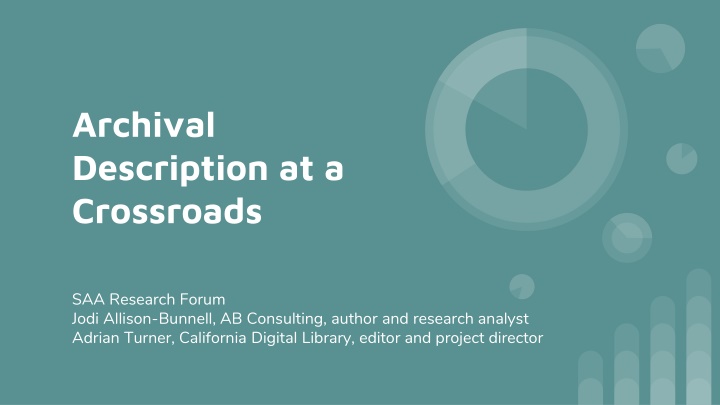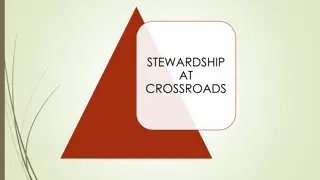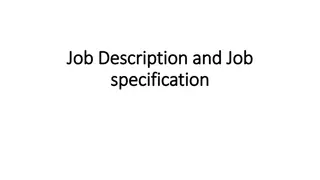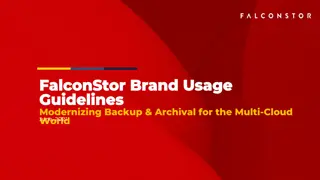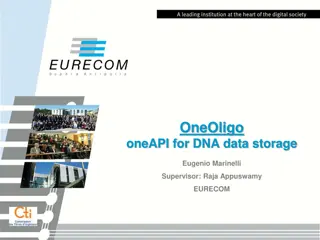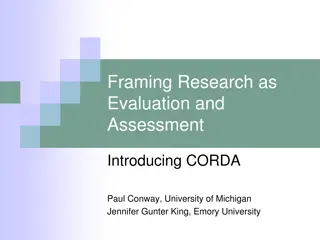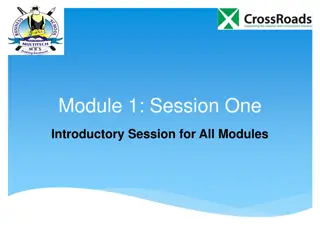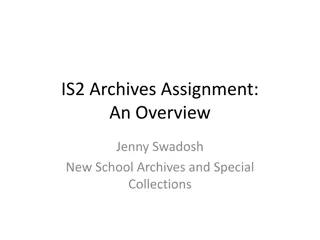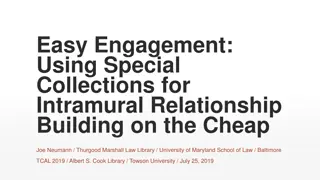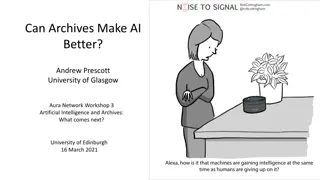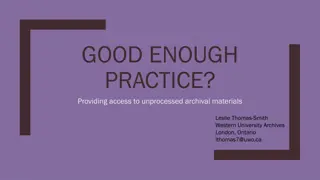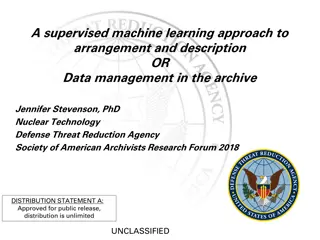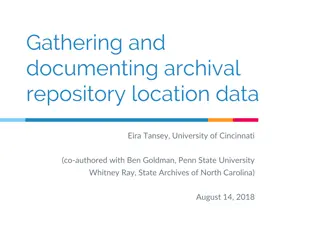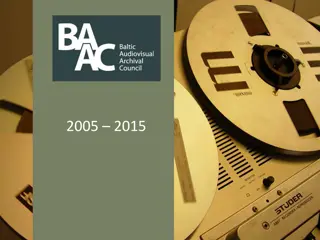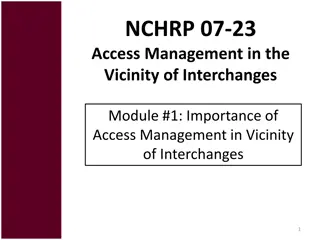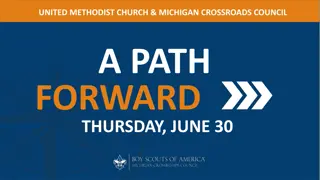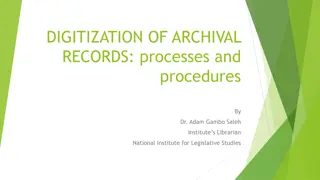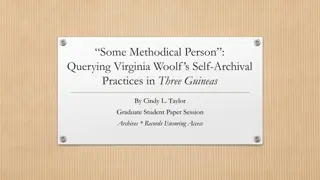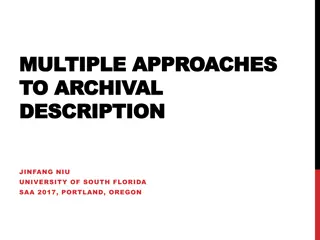Archival Description at a Crossroads
Delve into the state of finding aid aggregation, challenges faced by aggregators, and the potential of large-scale collaboration in this comprehensive research forum overview. Explore key project partners, expert advisors, and ongoing elements for a deeper understanding of archival description advancements and access improvements.
Download Presentation

Please find below an Image/Link to download the presentation.
The content on the website is provided AS IS for your information and personal use only. It may not be sold, licensed, or shared on other websites without obtaining consent from the author.If you encounter any issues during the download, it is possible that the publisher has removed the file from their server.
You are allowed to download the files provided on this website for personal or commercial use, subject to the condition that they are used lawfully. All files are the property of their respective owners.
The content on the website is provided AS IS for your information and personal use only. It may not be sold, licensed, or shared on other websites without obtaining consent from the author.
E N D
Presentation Transcript
Archival Description at a Crossroads SAA Research Forum Jodi Allison-Bunnell, AB Consulting, author and research analyst Adrian Turner, California Digital Library, editor and project director
Project Overview Archival description (finding aid) aggregation developed over last twenty years What is the state of aggregation? We think that many aggregators are struggling to update their platforms and to engage with some of the most promising advances in the field Toward a National Finding Aid Network Planning grant funded by California State Library LSTA program to the California Digital Library Could large-scale collaboration create efficiencies, increase effectiveness for end users and participants, and be more sustainable? 2018 October-2019 September
Project Partners Aggregators Meta-Aggregators Archival Resources in Wisconsin Arizona Archives Online California Digital Library (Online Archive of California) Chicago Collections Consortium Connecticut Archives Online Empire Archival Discovery Cooperative (EADC) Orbis Cascade Alliance (Archives West) Philadelphia Area Consortium of Special Collections Libraries (PAARP) Rhode Island Archives and Manuscripts Online Texas Archival Resources Online Virginia Heritage University of Nebraska Consortium of Libraries OhioLINK (OhioLINK Finding Aid Repository) Rocky Mountain Online Archive OCLC Research (ArchiveGrid) National Library of Medicine (History of Medicine Finding Aids Consortium) Social Networks and Archival Context (SNAC)
Expert Advisers Christine di Bella, ArchivesSpace Mark Matienzo, ArcLight Project Clifford Lynch, Coalition for Networked Information Michele Kimpton, Digital Public Library of America Roger Schonfeld, Ithaka S+R Mary Lacy, Library of Congress Leigh Grinstead, LYRASIS Don Waters, Mellon Foundation Jerry Simmons, National Archives Robert Horton, Smithsonian Institutions Raym Crow, SPARC
Project Elements In Process Complete Action plan for next phase of collaborative planning and implementation phases of future work Profile of finding aid aggregation in the United States and how it related to archival description and access Full-day symposium with partners and advisers
Definitions Aggregator: Program/organization that hosts or harvests descriptions of archival collections (mostly EAD finding aids) from institutions within a state or region. Meta-Aggregator: Program/organization that harvests finding aids and/or descriptions of archival context from institutions nationwide, or beyond.
Profile of Aggregation Landscape
Finding Aid Aggregation At A Crossroads In-depth surveys and interviews with all current and defunct U.S. state and regional aggregators and three meta-aggregators Context of current archival description landscape https://escholarship.org/uc/item/5sp1311 2
Methodology for Data Collection Surveys Interviews All current and defunct U.S. state and regional aggregators and meta-aggregators One or more representatives for each Mostly quantitative data Follow up and clarify responses to interview questions Quantitative questions that benefit from conversational approach Notes, recorded only for short- term reference
Methodology for Analysis Quantitative Analysis Qualitative Analysis Merged survey and interview data to produce a profile for each aggregator Merged data to create meta- analysis across all respondents Creation of charts and graphs to compare and present data Themes from responses, particularly from interviews Connections to landscape of description
High Level Findings Aggregators have increased the visibility of collections and exposed connections between them Current aggregations are not comprehensive for their state or region Aggregators built systems for hosting, indexing, and displaying EAD; those systems are aging, and there is no obvious successor solution Grant funding started, but has not sustained, most aggregations Most rely on a host institution, one or more champions, and the perception that they use no resources Few aggregators have invested in understanding their users This is a landscape ripe for evolution
Access to State or Regional Aggregator Repositories in half of U.S. states have access to an aggregator
Aggregators provide persistent hosting for significant numbers of EAD finding aids in the U.S. Number of Records Per Aggregator Aggregators host 127,516 EAD finding aids and 39,563 other records ArchiveGrid includes 195,659 EAD finding aids There is significant known (but not quantified) overlap
Aggregators host mostly EAD2002 (no EAD3) Meta-aggregators have mostly MARC and EAC-CPF Formats Hosted by Meta- Aggregators Formats Hosted by Aggregators
Value proposition Biggest value: Expose and facilitate search across collections at small or less well-known institutions and to reunite dispersed collections Strong shared ethics around open and equitable access Few have invested significantly in understanding their user audiences, and how they are changing For most contributing institutions, simple and utility-like infrastructure is adequate A smaller group is champing at the bit for innovation (LOD, etc.)
Current Resources are Scarce Sources Depend on Host Institutions Annual Aggregator and Meta- Aggregator Budgets Budget Sources
Grant Investment was Significant But Recent Focus is for Meta-Aggregation Grant Funding for Aggregators and Meta- Aggregators, 1999-2018 (includes SNAC and DPLA) Grant Funding by Year, 1999-2018 (without SNAC)
Conclusions It s time to take stock of the aggregation model as a community We need to become more user-centered It s time to consider how we can work together toward a robust, sustainable infrastructure that broadens access to collections We have a deep commitment to providing persistent and high quality access to archival collections regardless of which institution holds them
Do we continue archival description/finding aid aggregation as is, or do something new and larger scale?
Discussions Sustainable resourcing: What creates conditions for sustainability? Value: What is the present value of aggregation? What could be the value? Requirements: What is needed to meet the requirements we identified in Value?
Status Quo is Risky Users can t find what they need Aggregations are organizationally and financially fragile If aggregations fail, we may lose archival descriptions in which institutions, aggregators, and funders have invested substantial resources We d do it differently if we could
We Chose Action! Longer term: Take transformative action to provide the value that the current approach does not provide. Near term: Sustain the value that archival description aggregation currently provides by promoting inter-aggregator collaboration. Provide entry points to resources in the United States that that integrated description, content, and context Work with all description levels, from item to repository Develop shared infrastructure Save the metadata!
Requirements Serve End Users Involve end users to shape creation and development Support discovery that gets end users as close to the full resource as possible Provide access that is about rather than where Be Inclusive and Comprehensive Recognize the value of under-represented collections Provide end user service that is of value for better-resourced institutions Reduce Local Work Support low barriers to entry by Taking many forms of existing metadata Integrating with related tools Automating contribution processes Setting minimal (but strict) requirements
Action Plan Complete by September 30, 2019
Thank you! Jodi Allison-Bunnell, AB Consulting, http://consulting.allison-bunnell.net Adrian Turner, California Digital Library, Adrian.Turner@ucop.edu
